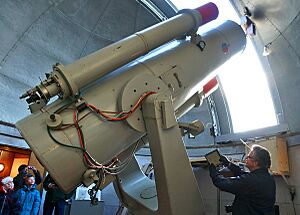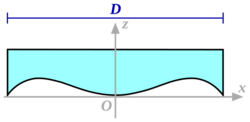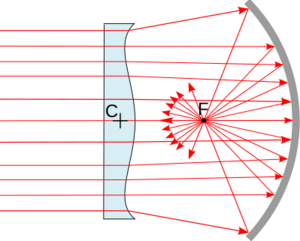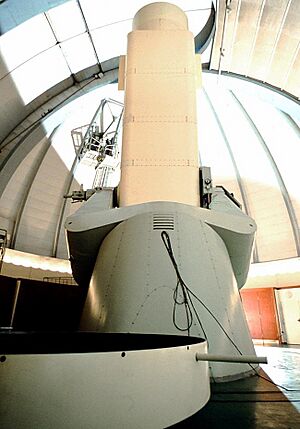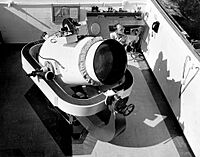Schmidt camera facts for kids
A Schmidt camera, also known as a Schmidt telescope, is a special type of telescope. It's designed to take pictures of very large areas of the sky, called a wide field of view, without much blur or distortion. This clever design was created by Bernhard Schmidt in 1930.
Some famous Schmidt telescopes include the Samuel Oschin telescope (also known as the Palomar Schmidt) and the UK Schmidt Telescope. These telescopes were super important from the 1950s to 2000. They took most of the all-sky photos we had before digital cameras took over. A more recent example is the Kepler space telescope, which used a Schmidt design to find planets outside our solar system!
Contents
How Schmidt Cameras Were Invented and Designed
The Schmidt camera was invented by an Estonian-German scientist named Bernhard Schmidt in 1930. It uses two main parts:
- A simple, bowl-shaped primary mirror.
- A special, wavy piece of glass called a Schmidt corrector plate. This plate is placed in front of the mirror.
The camera's film or digital sensor sits inside the telescope, right where the light comes to a sharp focus. This design is great because it can collect a lot of light quickly, making it "fast." It also helps to fix common problems like blurry edges in photos.
One challenge with Schmidt cameras is that the surface where the light focuses is very curved. This means the film or sensor needs to be curved too! Sometimes, special curved film is used. Other times, flat film is bent into the right shape using clips or even a vacuum. There's also a small lens called a "field flattener" that can help make the image flatter.
A small part of the light is blocked by the film holder or sensor, which sits in the middle of the telescope tube. This can slightly reduce the image quality.
What is a Schmidt Corrector Plate?
A Schmidt corrector plate is a uniquely shaped lens. It fixes a problem called "spherical aberration" that happens when a simple bowl-shaped mirror is used. This problem makes images blurry. The corrector plate was invented by Bernhard Schmidt in 1931. Some people think another astronomer, Yrjö Väisälä, might have invented something similar earlier in 1924.
The Schmidt corrector plate is used in Schmidt telescopes and other similar designs. It's also found in some camera lenses and projection systems that use bowl-shaped mirrors.
How Does a Corrector Plate Work?
Schmidt corrector plates work by having a special wavy shape that exactly cancels out the blur from the main mirror. Imagine light hitting the outer part of the mirror and the inner part of the mirror. Without the corrector, these light rays would focus at slightly different points, making the image blurry.
The corrector plate is thicker in the middle and at the edges. This special shape bends the light rays just enough so that all the light, no matter where it hits the mirror, comes together at the same sharp focus. The corrector plate only fixes this specific blur; it doesn't change how much the telescope magnifies things.
How Are Corrector Plates Made?
Making a Schmidt corrector plate is tricky! Here are a few ways it's done:
- Classical Method: Skilled optical engineers carefully grind and polish the wavy shape directly into a flat piece of glass. This takes a lot of practice and precision.
- Schmidt's Vacuum Method: Bernhard Schmidt himself came up with a clever way. He would place a thin, flat glass disk on a metal pan. He would then suck the air out from under the glass, causing it to bend slightly. While it was bent, he would grind and polish the top surface into a perfect sphere. When the vacuum was released, the glass would spring back, and the top surface would have the exact wavy shape needed for the corrector plate! This method isn't used much today because it's hard to keep the shape perfect.
- Modern Vacuum Method: In 1970, a new method was invented for a company called Celestron. They use a special pan that already has the correct wavy shape carved into its bottom. When a flat glass disk is placed on it and a vacuum is applied, the glass bends to match the pan's shape. Then, the top surface is polished flat. When the vacuum is released, the glass has the perfect corrector plate shape. This method makes it easier to make many corrector plates that are exactly the same.
Because making these plates is so hard, other scientists like Dmitri Dmitrievich Maksutov and Albert Bouwers came up with different telescope designs that use simpler lenses.
What Are Schmidt Cameras Used For?
Because Schmidt cameras can see a very wide area of the sky, they are often used for "sky surveys." This means they take pictures of huge parts of the sky to find new objects or track changes.
They are great for:
- Making maps of the stars and galaxies.
- Searching for comets and asteroids.
- Looking for new stars that suddenly get brighter, called novas.
Schmidt cameras are also used to track artificial satellites orbiting Earth.
Schmidt Cameras on Earth
The first big Schmidt telescopes were built in Germany and the USA just before World War II. After the war, many more large ones were built around the world.
One very famous Schmidt camera is the Samuel Oschin telescope at Palomar Observatory in California, finished in 1948. This telescope was used for huge sky surveys that created detailed maps of the sky.
The European Southern Observatory in Chile and the UK's Science and Engineering Research Council in Australia also used large Schmidt telescopes to map the southern sky. The Karl Schwarzschild Observatory in Germany has the largest Schmidt camera in the world!
Schmidt Cameras in Space
A Schmidt telescope was a key part of the Hipparcos satellite, launched by the European Space Agency in 1989. This satellite measured the distances to over a million stars with amazing accuracy!
The Kepler photometer on NASA's Kepler space telescope (launched in 2009) was the largest Schmidt camera ever sent into space. Kepler used its wide view to stare at one patch of sky for years, looking for tiny dips in starlight that could mean a planet was passing in front of its star.
Other Uses for Schmidt Systems
In the 1970s, a company called Celestron sold 8-inch Schmidt cameras for amateur astronomers. These cameras were designed to be very easy to use.
The Schmidt design was also used in reverse for early television projection systems. These systems projected images onto a large screen, like in theaters or even for home use.
Different Kinds of Schmidt Designs
Scientists have come up with several variations of the original Schmidt camera design to improve it or make it more compact.
Lensless Schmidt
In the 1930s, Schmidt realized that for certain slower telescopes, you could remove the corrector plate entirely and still get good images by just using a small opening in front of the mirror.
Schmidt–Väisälä Camera
Yrjö Väisälä designed a camera similar to Schmidt's but added a special lens in front of the film holder. This helped to flatten the curved image, making it easier to use.
Baker–Schmidt Camera
In 1940, James Gilbert Baker changed the Schmidt design by adding a second, smaller mirror. This mirror bounced the light back towards the main mirror, allowing the photographic plate to be placed closer to the front of the telescope.
Baker–Nunn Camera
The Baker–Nunn design, created by Baker and Joseph Nunn, replaced the corrector plate with a small set of three lenses near the focus. These cameras were very fast and powerful. A dozen of these huge cameras, each weighing 3.5 tons, were used by the Smithsonian Astrophysical Observatory to track artificial satellites from 1958 into the 1970s.
Schmidt–Newtonian Telescope
By adding a flat mirror at an angle inside a Schmidt telescope, you get a Schmidt–Newtonian telescope. This mirror directs the light out the side of the telescope tube, making it easier to look through.
Schmidt–Cassegrain Telescope
Adding a curved secondary mirror that sends light back through a hole in the main mirror creates a Schmidt–Cassegrain telescope. These are very popular with telescope makers because they are compact and use simple, easy-to-make mirrors.
Famous Schmidt Cameras Around the World
Here is a list of some important and large Schmidt cameras:
| Selected Large Schmidt Cameras by Year | |||||||
| Observatory | Size (Aperture) | Year Built | Special Note | ||||
|---|---|---|---|---|---|---|---|
| Palomar Observatory | 46 cm | 1936 | First in North America | ||||
| Palomar Observatory | 122 cm | 1948 | The famous Samuel Oschin telescope | ||||
| Hamburg Observatory | 80 cm | 1954 | Later moved to Calar Alto Observatory | ||||
| Karl Schwarzschild Observatory | 134 cm | 1960 | The largest one on Earth! | ||||
| Konkoly Observatory | 60 cm | 1962 | Located in Hungary | ||||
| Kvistaberg Observatory | 100 cm | 1963 | Largest in Scandinavia | ||||
| La Silla Observatory | 100 cm | 1971 | Part of the European Southern Observatory | ||||
| UK Schmidt Telescope | 120 cm | 1973 | Located in Australia | ||||
| Kepler photometer | 95 cm | 2009 | The largest one launched into space! | ||||
See Also
- List of telescope types
- Maksutov telescope
- Meniscus corrector
- Wright camera



